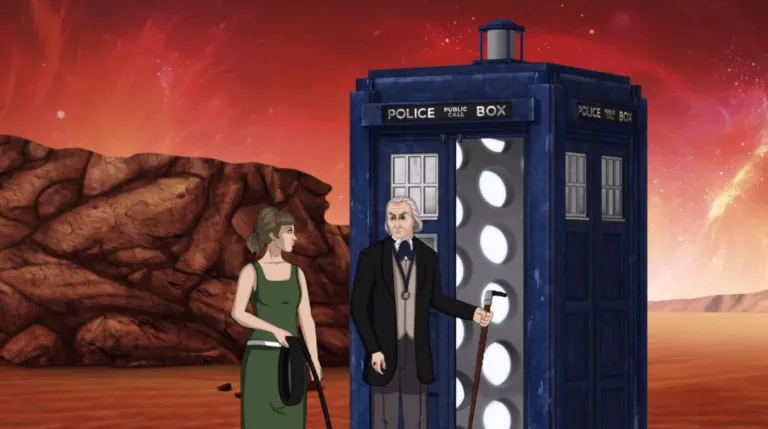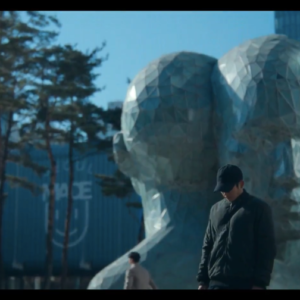The Doctor: First Doctor (William Hartnell)
The Companions: Vicki (Maureen O’Brien), Steven (Peter Purves)
The plot: The Doctor and his companions find themselves on an arid planet on the edge of destruction and in between two opposing forces: the warlike but humanoid Drahvins and the completely alien Rills.
Written By: William Emms
First aired: 11/09/1965-02/10/1965
Continuity: None
Season 3, Episodes 1-4 review

Galaxy 4 is an odd beast to review. With a good concept but mediocre execution, it’s made posthumously more interesting by the animation released in 2021. While I won’t comment on the technical aspects of animation (Vicki’s arms! Tonal inconsistencies!), I loved the striking, alien landscape portrayed in the new episodes compared to the cellophane and papier-mache creation of the original sets. And while the interiors of the animation are not as strong as the red desert of the planet itself, it gives the serial a vibrant, warm patina and an air of the truly alien.
The plot of Galaxy 4 is simple, which again lends it to animation more than other, more complex stories. Taking place on a planet that’s about to be torn apart by gravitational forces, it has minimal characters and only two settings apart from the planet’s surface itself: the Rill ship and the Drahvin ship.
Peter Purves famously disliked this story and looking at it now you can see why. Emms had written it for the previous companions and not enough work was put into adapting it for the new characters. As well as Steven being out of character for most of it, it has such head-scratching scenes as an astronaut not knowing what an airlock is.


With the rise of second wave feminism in Britain, Emms also decided to gender switch the fascist Drahvins so they’re a society of women, which is the kind of tone deaf thing a 1960s writer would do. Seen inevitably through a male gaze, the Drahvin society then becomes more akin to Amazons than militant nationalists and leads inevitably to Steven making a number of out of character remarks about their physical attractiveness. Although to be frank I can’t see Ian or Barbara making these comments either so the whole thing lands badly either way.
The serial begins when the TARDIS lands on a dusty red planet. The blue box is immediately accosted by super cute robots that Vicki names Chumblies for pop culture reasons that have been lost to time and have something to do with their movements. I think these are supposed to be menacing, but they’re mostly just adorable: like the Daleks made a robot pet.
The TARDIS crew is ‘rescued’ from the Chumblies by the Drahvins: a group of cloned warrior women who unquestioningly obey their leader, Maaga. Maaga tells the travellers that the Chumblies work for the evil Rills, who shot them down and are trying to kill them. She delivers this information with so much staccato militancy and thinly-veiled xenophobia that it becomes almost immediately obvious she’s lying. As such, the reversal of expectations here – that the attractive, humanoid Drahvins are evil and the alien, reptilian Rill are good – is almost immediately telegraphed. Also it’s a society run by women and we all know that can’t end well.


Both groups are trying to repair their ships in time to escape the planet’s destruction. The Rills have almost finished but the Drahvins won’t be able to do it in time. The Rills have offered to help the Drahvins but Maaga can only see an alien being as an enemy. She’s intent on stealing their ship instead.
Because they’re evil. You only have to see them to know. Evil!
Maaga on the Rill
Maaga keeps Vicki hostage while the Doctor and Steven head back to the TARDIS to confirm the planet is in danger. The Doctor confirms the planet will explode but in one day, not the two weeks the opposing forces think they have. When the Doctor reports this back to Maaga, she then takes Steven hostage and sends the Doctor and Vicki off to trick the Rills so they can steal their ship.
And, again, with all the hostage-taking going on, it’s very clear the Drahvins are the real antagonists here and we haven’t even met the Rills yet.
While Steven is a prisoner in episode 3, Maaga gets to deliver the show’s best monologue. The third episode of Galaxy 4 is the only one that survived the wiping, so we have the original footage of Stephanie Bidmead’s powerful performance as Maaga, something that is lost in the animated version of the character.

She bemoans the clones’ lack of imagination and intelligence, plans the destruction of both the Rills and the TARDIS crew, and then breaks the fourth wall as she says that her capacity to think means that she can delight in the death of her enemies even if she doesn’t witness it.
It’s an intense scene that uses Bidmead’s physicality to convey the character’s superiority, ruthlessness and desire to conquer layered with her frustration at being surrounded by automatons who can only kill and obey orders. By breaking the fourth wall, we get to stare straight into the eyes of a maniac who relishes her role as conqueror. It’s this performance that makes sense of her decision to kill Steven in the airlock, something that is more cruel than calculated. It’s the scene that makes me wonder if I was wrong to think the animation improved Galaxy 4 or instead detracted from it. The animation certainly didn’t convey the extent of Maaga’s megalomania that would lead her to try to kill her only bargaining chip.

The Doctor and Vicki head across the red planet to the Rill ship, which is modern, cavernous and based on a design involving triangles and pyramids. In line with the first Doctor’s 19th century views on technology and society, he is far happier with the advanced Rill ship versus the Drahvin’s decaying one, seeing it as evidence of a superior civilisation.
The Rills are ammonia breathing aliens who initially struggle to communicate because they are telepathic and have no vocal chords. The first sight of them terrifies Vicki and she and the Doctor try to run. The Rills instead separate them so that they can divine their purpose in being there and whether they’re working for the Drahvins. The Doctor, believing that Vicki is in danger, tries to sabotage the machine the Rills are using to turn the planet’s atmosphere into ammonia gas.
Turns out of course the Rills are explorers while the Drahvins are conquerors. The two groups met in space. The Drahvins fired first, the Rills fired back. Both ships crashed. The Rills sent the Chumblies to see if the Drahvins needed help and saw Maaga kill her own injured crew member.
There’s a question here as to why Maaga – whose entire crew are clones bred to unquestioningly obey her – would feel the need to cover up that she killed the clone or to false flag the death by blaming it on the Rills. The social commentary is obvious, the in-show logic not so much. Especially when this episode has clones agreeing that helping a fallen comrade makes little sense.


The Rills help to rescue Steven from the Drahvins but the Doctor finds out that they cannot leave. Their ship may be repaired but they lack an energy source and the only one they could find on the planet was a gas they couldn’t convert. The Doctor plans to transfer power from the TARDIS to the Rills ship so they can leave.
On paper, the final episode of Galaxy 4 is a race for the Doctor to help the Rills power their ship so they can leave while the Drahvins try their best to steal it so they can escape alone. But really, the story belongs to the Drahvins (who have come from Galaxy 4 if you want a rather tangential reason for the serial’s title).
Not a lot is known of the Drahvin’s homeworld but it seems they are an insular, xenophobic and militaristic society set on intergalactic conquest who have neither the technology nor the capability to do it. The final episode of Galaxy 4 is really about Maaga’s growing panic as she can see doom approaching but is unable to do anything about it. She truly believes she has only two options: steal the Rills’ ship or die. She is incapable of accepting there is a third option of trusting the Rills and so her death becomes inevitable. The Drahvins are entirely the architects of their own destruction. From their decision to fire on the Rills to their refusal to accept anybody else’s help, the Drahvins doomed themselves.
In comparison, as a statement on xenophobia, the Rills are an excellent one (although the animation renders them less terrifyingly alien and more plushie toy cute). Non-violent to a fault and living in a universe full of bipedal oxygen breathers, they veer from patronising not everybody in the universe looks likes you lectures to self-consciousness as they hide rather than be judged for their appearance. The Rills saddeningly blame themselves for the Drahvin’s hatred and disgust, thinking that if they were less different the Drahvins would not have been so scared of them. When of course the Drahvins would have hated them no matter what.

Galaxy 4’s biggest flaw then is in its execution. As an episode of Doctor Who it naturally focusses on the characters we know and presumably care about – the Doctor and his companions – when the contrast between the Drahvins and the Rills is the real story here.
In particular, Maaga’s story is a classic tragedy whereby her own character flaws entirely drive her downfall rather than any external stimulus. A dictator in a bottle whose self-image wars constantly with the reality of the world around her, she is one of the most interesting antagonists the show has devised. And Bidmead’s performance, thankfully surviving in one small remnant, brings the character to vibrant life.
Galaxy 4 ends of course with the Rills taking off and the TARDIS dematerialising into time and space. As the planet breaks up, Maaga meets the same fate she was relishing inflicting on her enemies. But unlike her and the other Drahvins, the Doctor, Steven and Vicki don’t look back to enjoy the moment. They’re on to their next adventure.




One thought on “Galaxy 4: Doctor Who, S3 Serial 1”